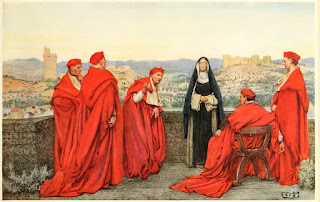When the Visigoths attacked Rome, the siege prevented the deceased from being buried in the cemeteries outside the walls, and so the area around the Colosseum became a large burial site. After the Fall of Rome and the sacking by the Visigoths, attempts were made to repair and utilize it, but the budget and management no longer existed for "bread and circuses."
A series of earthquakes and restoration attempts took place over the next few centuries. Eventually its management fell to the most influential institution in Rome: the papacy. Between the 9th and 14th centuries, this extensive structure had many new uses, managed by the priests of Santa Maria Nova. Its underground tunnels and compartments, where staff and fighters and animals were once housed and fed and trained, became apartments and shops. The open arena was left as a sort of common area for people working and living in the building. "Row houses" were built against the north side.
(There was even a moment in 1200 when it became the home to a single wealthy family, the Frangipani.)
The illustration here is a 16th century woodcut showing the round design, but an earthquake in 1349 (as if they weren't dealing with enough tragedy with the Bubonic Plague) caused part to collapse, and its use as a rental property faded away. Also, the move of the papacy to Avignon caused Rome's population to dwindle, and the need for housing in the Colosseum (and therefore the need and income to maintain it) also dwindled.
After the return of the popes to Rome, the building (what was left) became the home of a religious order. Over the centuries, other purposes were found. One pope wanted to make it a wool factory to provide alternate jobs for the city's prostitutes. A cardinal in 1671 wanted to use it for bullfights. Both plans failed to materialize.
The Colosseum became a source of building material. The lead piping that carried water was taken and melted for other uses. The iron clamps that held stone blocks together were pried out and re-forged. The stone itself—marble and travertine—was taken and used for other buildings.
Some of the marble was burned to make quicklime. What was quicklime, and what was its use in the Middle Ages? I'll tell you tomorrow.












